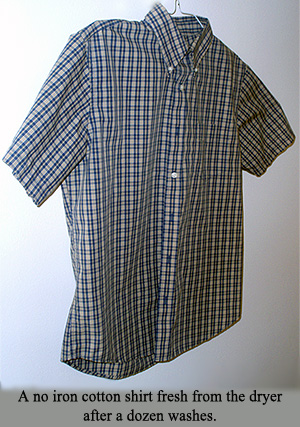Wrinkle Free Cotton
by Andrew Boyd
Today, we wash and wear. The University of Houston's College of Engineering presents this series about the machines that make our civilization run, and the people whose ingenuity created them.
The way we launder clothes has come a long way from trips down to the river, pounding fabric on rocks. We have washing machines, dryers, and an assortment of additives — specially engineered soaps, stain removers, and fabric softeners. And if we're a little careful, we can get by without ironing — thanks in large part to a woman named Ruth Benerito.
Benerito was born in 1916 in New Orleans — a time and place where women were expected to remain at home. But thanks to a dedicated father, she entered Tulane University at the age of fifteen. There, Benerito was one of only two women given permission to take chemistry classes. She ultimately completed a Ph.D. in physical chemistry at the University of Chicago.
Almost all cotton clothing is wrinkle free these days. But without proper chemical treatment, cotton wrinkles badly when it gets wet. For most of the twentieth century, ironing boards were household fixtures as women spent hours a day making our cotton clothes look good.
So when synthetic fabrics like nylon appeared in the mid 1930s, they posed a challenge for the cotton growers. Properly cared for, synthetic fabrics are less prone to wrinkling than their cotton counterparts. Would consumers give up the feel of cotton for the convenience of synthetics? It was a real possibility.
Enter Benerito. While working at the U. S. Department of Agriculture, she came up with an idea for treating cotton fabric. It made cotton molecules line up more like those found in synthetic polymers through a process called cross-linking. The result? Permanent press.

Her process went through many refinements. It was good for clothes made of heavy materials, like pants, but weakened the cotton too much for thinner items. A big breakthrough came in 1993, when Japanese manufacturers introduced the no iron cotton shirt. And new no press processes are under constant development — processes that make the cotton last longer, resist stains better, and keep the cotton fibers strong.
But it all started with Benerito. She went on to file a total of fifty-five patents in her career. But her achievements certainly aren't limited to patents. She received the Lemelson-MIT Lifetime Achievement Award for her work on textiles, but also for her lifelong commitment to teaching. Benerito was a role model for generations of students, and taught well into her eighties.
In 1970, the Department of Agriculture conferred on her the distinguished service award — its highest honor. And in 2008, she was inducted into the National Inventors Hall of Fame — one of only fifteen women honorees. Remarkable achievements for anyone — but especially so for a young girl from the long-ago Mississippi delta.
I'm Andy Boyd at the University of Houston, where we're interested in the way inventive minds work.
An updated version of this episode can be found at Episode 3155.
Ruth Benerito. From the this Lemerson-MIT web site.
Pictures by E. A. Boyd.